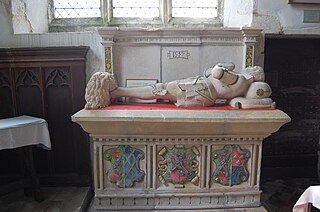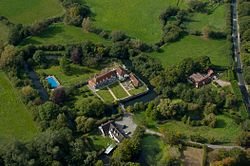
Hever Castle is located in the village of Hever, Kent, near Edenbridge, 30 miles (48 km) south-east of London, England. It began as a country house, built in the 13th century. From 1462 to 1539, it was the seat of the Boleyn family.

Baron Dacre is a title that has been created three times in the Peerage of England, each time by writ.

Baron Saye and Sele is a title in the Peerage of England held by the Twisleton-Wykeham-Fiennes family. The title dates to 1447 but it was recreated in 1603. Confusion over the details of the 15th-century title has led to conflicting order for titleholders; authorities such as Burke's Peerage and Debrett's Peerage do not agree on whether or not the 1447 creation is still extant.

Petworth House is a late 17th-century Grade I listed country house in the parish of Petworth, West Sussex, England. It was built in 1688 by Charles Seymour, 6th Duke of Somerset, and altered in the 1870s to the design of the architect Anthony Salvin. It contains intricate wood-carvings by Grinling Gibbons. It is the manor house of the manor of Petworth. For centuries it was the southern home for the Percy family, earls of Northumberland.

Herstmonceux Castle is a brick-built castle, dating from the 15th century, near Herstmonceux, East Sussex, England. It is one of the oldest significant brick buildings still standing in England. The castle was renowned for being one of the first buildings to use that material in England, and was built using bricks taken from the local clay, by builders from Flanders. It dates from 1441. Construction began under the then-owner, Sir Roger Fiennes, and was continued after his death in 1449 by his son, Lord Dacre. The castle has been owned by Queen's University at Kingston, a Canadian university, since 1993.

Hailsham is a town, a civil parish and the administrative centre of the Wealden district of East Sussex, England. It is mentioned in the Domesday Book, where it is called Hamelesham. in one part, yet mentioned in another part of the same book as ‘’’Tilux’’’, the land of Ricard de Tunbrige. The town of Hailsham has a history of industry and agriculture.

Withyham is a village and large civil parish in the Wealden district of East Sussex, England. The village is situated 7 miles south west of Royal Tunbridge Wells and 3.5 miles (5.6 km) from Crowborough; the parish covers approximately 7,500 acres (30 km2).

Hellingly is a village, and can also refer to a civil parish, and to a district ward, in the Wealden District of East Sussex, England.

Hangleton is a suburb of Brighton and Hove, in the ceremonial county of East Sussex, England. The area was developed in the 1930s after it was incorporated into the Borough of Hove, but has ancient origins: its parish church was founded in the 11th century and retains 12th-century fabric; the medieval manor house is Hove's oldest secular building. The village became depopulated in the medieval era and the church fell into ruins, and the population in the isolated hilltop parish only reached 100 in the early 20th century; but rapid 20th-century development resulted in more than 6,000 people living in Hangleton in 1951 and over 9,000 in 1961. By 2013, the population exceeded 14,000.
Walter Hindes Godfrey, CBE, FSA, FRIBA (1881–1961), was an English architect, antiquary, and architectural and topographical historian. He was also a landscape architect and designer, and an accomplished draftsman and illustrator. He was (1941–60) the first director and the inspiration behind the foundation of the National Buildings Record, the basis of today's Historic England Archive, and edited or contributed to numerous volumes of the Survey of London. He devised a system of Service Heraldry for recording service in the European War.

Blake Hall is a country house within the civil parish of Bobbingworth, to the northwest of Chipping Ongar, in the county Essex, England. It is recorded in the National Heritage List for England as a Grade II* listed building, and its park and garden are Grade II listed.

Coates is a downland village in the Chichester district of West Sussex, England. Coates lies one mile (1.7 km) southwest from Fittleworth and four miles (6.8 km) south-east-by-south from Petworth. It is within the ancient divisions of the Bury Hundred and the Rape of Arundel.The village is bounded north by the Rother Navigation.

The Archbishop's Palace is a Grade I listed historic 14th-century and 16th-century building on the east bank of the River Medway in Maidstone, Kent. Originally a home from home for travelling archbishops from Canterbury, the building has been most recently used as a venue for wedding services. The former tithe barn for the palace, now serves as the Tyrwhitt-Drake Museum of Carriages.

Prittlewell Priory is a medieval priory in the Prittlewell area of Southend, Essex, England. It was founded in the 12th century, by monks from the Cluniac Priory of St Pancras in Lewes, East Sussex, and passed into private hands at the time of the Dissolution of the Monasteries under Henry VIII. The last private owner, the jeweller R. A. Jones, gave the priory and the grounds to the local council. The grounds now form a public park, Priory Park, and the Grade I listed building is open to the public as a museum. The remains of the priory are a scheduled monument.

Hangleton Manor Inn, the adjoining Old Manor House and associated buildings form a bar and restaurant complex in Hangleton, an ancient village which is part of the English city of Brighton and Hove. The manor house is the oldest secular building in the Hove part of the city; some 15th-century features remain, and there has been little change since the High Sheriff of Sussex rebuilt it in the mid-16th century. Local folklore asserts that a 17th-century dovecote in the grounds has been haunted since a monk placed a curse on it. The buildings that comprise the inn were acquired by Hangleton Manor Ltd in 1968, and converted to an inn under the Whitbread banner. The brewery company Hall & Woodhouse have owned and operated it since 2005. English Heritage has listed the complex at Grade II* for its architectural and historical importance, and the dovecote is listed separately at Grade II.

Preston Manor is the former manor house of the ancient Sussex village of Preston, now part of the coastal city of Brighton and Hove, England. The present building dates mostly from 1738, when Lord of the manor Thomas Western rebuilt the original 13th-century structure, and 1905 when Charles Stanley Peach's renovation and enlargement gave the house its current appearance. The manor house passed through several owners, including the Stanfords—reputedly the richest family in Sussex—after several centuries of ownership by the Diocese of Chichester and a period in which it was Crown property.
Anne Fiennes, Baroness Dacre was an English gentlewoman and benefactress.
Sir Roger Fiennes (1384–1449) was an English knight of the shire, High Sheriff of Surrey and Sussex, and builder of Herstmonceux Castle. He was also Treasurer of King Henry VI's household.

Sir Goddard Oxenbridge, KB was an English landowner and administrator from Sussex.

Wings Place, formerly Ditchling Garden Manor, also known as Anne of Cleves House, is a Grade I country house in Ditchling, East Sussex, England. It is a Tudor house, said to be one of the best examples in the country.


















